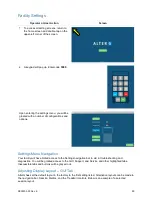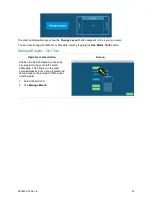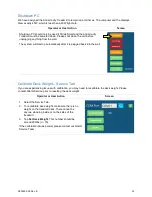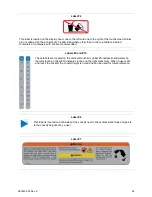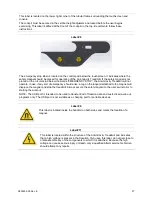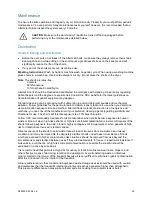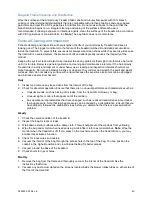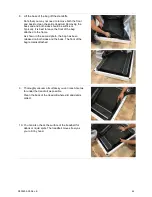
D000505-00 Rev. E
40
Bag and Frame Cleaning and Disinfection
Wipe the surfaces of the Anti-Gravity Treadmill fabric shell and tubular framework with 10% bleach
solution or other detergents/disinfectants that are compatible with urethane coatings and epoxy-based
paint films and meet the CDC’s guidelines for disinfection. Do not soak surfaces to the point that the
bleach solution begins to run. Regular cleaning and wiping of the surfaces after each use is
recommended. Following exposure to infectious agents, clean the surfaces of the treadmill in accordance
with CDC guidelines or consult AlterG, Inc.
Note
: The bag fabric does not contain latex.
General Cleaning and Inspection
Periodic cleaning and inspection will help lengthen the life of your Anti-Gravity Treadmill and keep it
looking good. The biggest contributor to the failure of the treadmill will be dirt and debris accumulation
inside the treadmill. To prevent this, ensure users always wear clean shoes while they exercise. Because
the treadmill is a sealed system, the presence of dirt and debris greatly reduces the longevity of the
product.
Keeping the system clean will also make it easier to see any problems that might not otherwise be found
until it is too late. Below is a general guideline on cleaning and maintenance intervals. If the Anti-Gravity
Treadmill is in a dirty environment or under heavy use, cleaning and inspection intervals should occur
more frequently. Do not use abrasive brushes or cleaners; they will mar and scratch the paint and plastic
surfaces. Also, do not soak any surface with a liquid because the sensitive electronics can be damaged
and introduce an electrical hazard.
Daily
1. Inspect and remove any loose debris from the interior of the bag.
2. Check for abnormal operation. Ensure that there are no unusual performance characteristics such as:
•
Unusual sounds, such as hissing of air leaks, from the treadmill, air blower, or bag.
•
Unusual sights or odors that appear out of the ordinary.
•
Any operational characteristics that have changed, such as reduced treadmill speed or erratic or
low bag pressure. Note that low bag pressure can be caused by a miscalibration. Ensure that you
have properly followed the calibration steps before you determine that there is a pressurization
problem.
Weekly
1. Check the overall condition of the treadmill.
2. Inspect the bag for tears or leaks.
3. Wipe down exterior surfaces with a damp cloth. This will help prevent the windows from yellowing.
4. Wipe the bag and monitor when needed using a microfiber cloth to avoid scratches.
Note
: Wipe the
monitor when the treadmill is off. If you press on the touchscreen when the treadmill is on, you may
accidentally activate a function.
5. Check for loose wires and cables.
6. Vacuum the interior of the bag through the access hole in the top of the bag. You can position the
cockpit in the highest position and crawl inside the bag for better access.
7. Vacuum around the base of the treadmill.
8. Check shorts for rips or holes.
Monthly
1. Remove the bag from the frame and thoroughly vacuum the interior of the treadmill. See the
instructions that follow.
2. Vacuum any dust accumulated on the screens located inside the blower intake tubes on either side of
the front of the treadmill.




